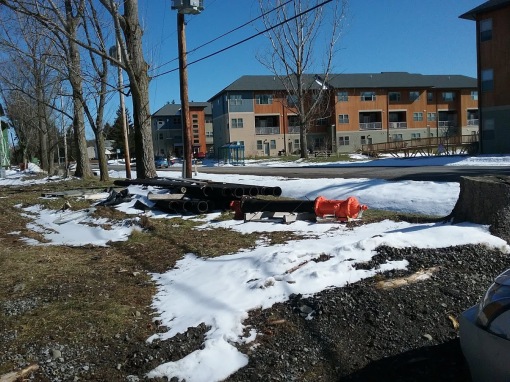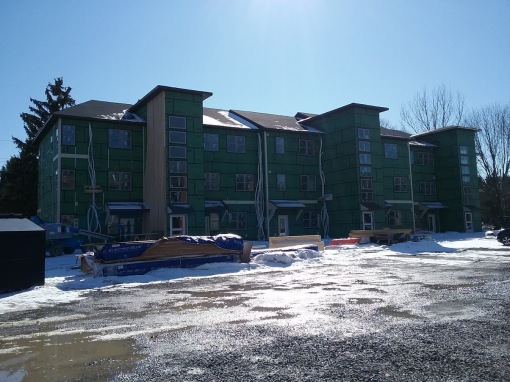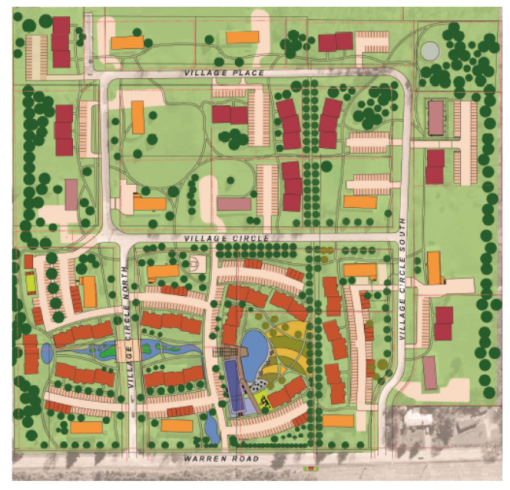Now, let’s take a look at some notable property sales over the past few weeks. To make this easy, most sales documented in this post will use a standardized format for each entry.
1. What sold and for how much? 8 and 28 Newfield Depot Road, the parcel IDs for the 188-unit Valley Manor Mobile Home Park in Newfield, for $2,300,000 on 12/19/2018.
Who was the seller? Jim Ray Homes, a local manufactured and mobile home dealer, and mobile home park operator.
Who was the buyer? Cook Properties of Rochester, a mobile home management firm with properties across upstate New York.
Anything else? Not especially. The sale was just short of the tax assessed value ($2.3 million vs. $2.369 million), and while it’s a change of ownershipp, it’s also likely a maintenance of the status quo. Still, it’s a high-dollar sale worth noting. The assessment for mobile homes and manufactured homes is a bit funky, and I think the owners only own the lots, which likely contributes to the low price per unit.

2. What sold and for how much? 232 South Geneva Street for $533,000 on 12/20/2018, and 311-13 Farm Street in Fall Creek for $700,000 on 12/20/2018. 232 South Geneva is a 5-unit apartment building in the Henry St. John neighborhood; it sold for $302k in 2013, and $200k in 2008. 311-13 Farm Street is a 3-unit apartment building that sold for $505k in 2009. It includes 15 rentable bedrooms, and a portion that was set aside as an AirBnB by the previous owners, who had it on the market for $750k (assessment $610k). Both are small multi-family examples of the rapid price appreciation Tompkins County has been seeing in walkable urban areas.
Who was the seller? Jeremy Dietz for 232 South Geneva, and S&Y Investments, a California-based LLC (sales docs indicate the owners are John Scarpulla and Allyson Yarbrough) for 311-13 Farm Street.
Who was the buyer? An LLC associated with local landlord and developer Charlie O’Connor, owner of Modern Living Rentals.
Anything else? Don’t expect teardowns here. Generally speaking, that’s not MLR’s approach to Ithaca’s inner neighborhoods. Do expect them to stay rentals, probably with a renovation in the near future (see: 1002 North Cayuga Street and 202-04 East Marshall Street). O’Connor is flush with cash after his multi-million sale of the under-construction 802 Dryden Road to a Pittsburgh-based real estate investor last fall.

3. What sold and for how much? The Sprucewood Apartments in Northeast Ithaca, for $8,640,000 on 12/21/2018. Sprucewood is a 108-unit apartment complex completed in 1966. All units are three-bedrooms, in eighteen six-unit buildings.
Who was the seller? The Lucente family, who run Lifestyle Properties in Ithaca. They own a host of other housing developments, including the Village Solars under construction in the town of Lansing.
Who was the buyer? Winston Square LLC, an LLC associated with Stratford Management, a multifamily housing management firm with locations in six states.
Anything else? A case of “under new management”. The Lucentes are a whole lot richer, and Stratford, which mostly owns older apartment complexes across upstate, finally gets a toehold in the stable and lucrative Ithaca market. With it comes a new website and a name change, from Sprucewood to Winston Square. The apartments are primarily located on Winston Court, and the name comes from the late Rocco Sr.’s penchant for naming streets after cigarette brands in the 1950s and 1960s, hence the nickname “Cigarette Alley” for Northeast Ithaca. I don’t imagine that will be a part of the advertising pitch.

4. What sold and for how much? 815 South Aurora Street, for $385,000. The property includes a 2,845 SF industrial building and a 2,537 SF warehouse on 1.85 acres on South Hill. A radio and telecommunication tower is on site.
Who was the seller? Harold Fish. The Fish family has owned the property since at least the 1950s.
Who was the buyer? “IC Overlook LLC”, which appears to be associated with Modern Living Rentals and its owner, Charlie O’Connor.
Anything else? With Todd Fox, O’Connor proposed an 87-unit (all studio units) apartment building for the site in 2015, and in order to move forward, the duo had to make a case for the city to change its rules for building near radio and telecommunication towers. Most communities use the height plus 10 feet; at the time, Ithaca used double the height. This is a 170-foot tower, so that meant a 340 foot radius, instead of 180 feet as seen in most communities. The logic is the height plus a bit for bounce; but planning staff mused that Ithaca was a bit paranoid when the legislation was drawn up in the 1990s. The zoning code was revised, but such that it’s height plus 20% – a 204 foot radius, so the project had to be redesigned a bit. The last that was heard, plans were being for a 125-bedroom project in December 2016, but nothing came to light.
Until now. A sketch plan is scheduled for the planning board meeting next week.

5. What sold and for how much? 327 West Seneca Street, for $235,000 on January 11th.
Who was the seller? The estate of Orson Ledger, a man who was known in his decades of Ithaca for providing affordable housing by running his properties into the ground so that assessments would be low. Folks involved with Ithaca’s rental market in decades past tend to have strong opinions about Ledger, who died in a car accident five years ago.
Who was the buyer? An LLC tied to Visum Development Group.
Anything else? It means Visum’s 12-unit workforce housing proposal approved for 327 West Seneca Street is now one step closer to happening.
6. What sold and for how much? 305 West Green Street, for $560,000 on January 17th. 305 West Green Street is the former Ithaca Plastics. The property hosts a 2,400 SF home and a 5,150 SF industrial building.
Who was the seller? Richard and Sharon Buechel of Dryden, who had owned the property since 1989.
Who was the buyer? Cascade Studios LLC, which is registered to the address of Ithaca musician Brian Thrash.
Anything else? Generally not wise to take guesses on these sort of things, but plans for a music/recording studio, perhaps?
7. Something that catches the eye – local landlord Ed Cope has been actively selling off many of his rental properties. 310 Farm Street was sold for $365,000 on 12/28 to Jonah and Alicia Freedman, as was 312 Farm Street, for $395,000 on the same day. 513 South Aurora Street was also sold on December 28th, to Andrew Schreck for $425,000. Cope sold out of his share of 324 West Seneca Street for $180,200 on January 17th, and sold out of his share of 318-20 West Seneca on the same day for $349,800. That’s in addition to the sale of 115 Linn Street for $540,000 last October. That’s six sales in four months.
Vice-versa, Cope bought 107-09 Hudson Street from the estate of Sophia Tselekis for $540,000 on January 10th. Previously, Cope purchased 115 Hudson for $495,000 in October, and 108-110 Hudson Street for $460,000 in September.
All of this is to suggest that Ed Cope has been a very busy man lately. It would look as if he’s selling off properties to finance purchases of other properties clustered on the 100 Block of Hudson Street, just south of downtown and Six Mile Creek. Cope already owns 105 Hudson Street and 201 South Aurora Street on the corner, 114 Hudson, 117 Hudson and 118-120 Hudson. That leaves three properties in that cluster of eleven that he doesn’t own – 101, 111 and 112 Hudson Street. It’s not clear if something is in the works, but it is curious.
Now onto building loan agreements:

8. Where property received the construction loan? 232-236 Dryden Road, also known as “The Lux”, a 206-bedroom pair of student-oriented apartment buildings completed in 2018. Visum Development Group completed the project, and plans are in the works for an eight-unit, 16-bedroom third building at 238 Dryden Road.
Who gave them the money? MF1 Capital LLC. The LLC is joint venture between real estate megafirm CBRE, Limekiln Real Estate of New York and Berkshire Group of Boston. According to online reports, it’s a mortgage REIT (Real Estate Investment Trust) focused on providing cash equity to multifamily (about 75% of its business) and seniors housing (the remaining 25%). A bridge loan is a short-term (2-3 year) financial solution, used as a “bridge” when a developer needs quick cash for a prime opportunity and has yet to obtain conventional construction loans. They’re usually easier to obtain because the analysis that goes into determining whether or not to extend the loan is less extensive, usually based on property value (which means a high-value loan in the case of a large Collegetown property). The trade off on these loans is that they often come with a high interest rate; and with that short term period, the loan will have to be paid back within a few years.

What it suggests here is that Visum has put most of its revenue right back into its latest plans in the form of working capital, and that there’s high confidence both in themselves and from the investor that those plans will be successful. That seems to make the most sense given Visum’s explosive growth. On a related note, $1.5 million would be about right for a new eight-unit apartment building on this site.


















































































































































